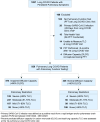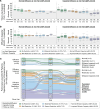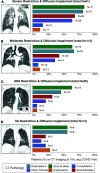Characteristics and determinants of pulmonary long COVID
- PMID: 38652535
- PMCID: PMC11141907
- DOI: 10.1172/jci.insight.177518
Characteristics and determinants of pulmonary long COVID
Abstract
BACKGROUNDPersistent cough and dyspnea are prominent features of postacute sequelae of SARS-CoV-2 (also termed "long COVID"); however, physiologic measures and clinical features associated with these pulmonary symptoms remain poorly defined. Using longitudinal pulmonary function testing (PFT) and CT imaging, this study aimed to identify the characteristics and determinants of pulmonary long COVID.METHODSThis single-center retrospective study included 1,097 patients with clinically defined long COVID characterized by persistent pulmonary symptoms (dyspnea, cough, and chest discomfort) lasting for 1 or more months after resolution of primary COVID infection.RESULTSAfter exclusion, a total of 929 patients with post-COVID pulmonary symptoms and PFTs were stratified as diffusion impairment and pulmonary restriction, as measured by percentage predicted diffusion capacity for carbon monoxide (DLCO) and total lung capacity (TLC). Longitudinal evaluation revealed diffusion impairment (DLCO ≤ 80%) and pulmonary restriction (TLC ≤ 80%) in 51% of the cohort overall (n = 479). In multivariable modeling regression analysis, invasive mechanical ventilation during primary infection conferred the greatest increased odds of developing pulmonary long COVID with diffusion impairment and restriction (adjusted odds ratio [aOR] = 9.89, 95% CI 3.62-26.9]). Finally, a subanalysis of CT imaging identified radiographic evidence of fibrosis in this patient population.CONCLUSIONLongitudinal PFTs revealed persistent diffusion-impaired restriction as a key feature of pulmonary long COVID. These results emphasize the importance of incorporating PFTs into routine clinical practice for evaluation of long COVID patients with prolonged pulmonary symptoms. Subsequent clinical trials should leverage combined symptomatic and quantitative PFT measurements for more targeted enrollment of pulmonary long COVID patients.FUNDINGNational Institute of Allergy and Infectious Diseases (AI156898, K08AI129705), National Heart, Lung, and Blood Institute (HL153113, OTA21-015E, HL149944), and the COVID-19 Urgent Research Response Fund at the University of Alabama at Birmingham.
Keywords: Bioinformatics; Diagnostic imaging; Diagnostics; Infectious disease; Pulmonology.
Figures



Update of
-
Characteristics and Determinants of Pulmonary Long COVID.medRxiv [Preprint]. 2024 Feb 14:2024.02.13.24302781. doi: 10.1101/2024.02.13.24302781. medRxiv. 2024. Update in: JCI Insight. 2024 Apr 23;9(10):e177518. doi: 10.1172/jci.insight.177518. PMID: 38405753 Free PMC article. Updated. Preprint.
References
-
- Bull-Otterson L, et al. Post–COVID conditions among adult COVID-19 survivors aged 18–64 and ≥65 Years — United States, March 2020–November 2021. MMWR Morb Mortal Wkly Rep. 2022; 71(21):713–717. doi: 10.15585/mmwr.mm7121e1. - DOI
MeSH terms
Grants and funding
LinkOut - more resources
Full Text Sources
Medical
Miscellaneous

